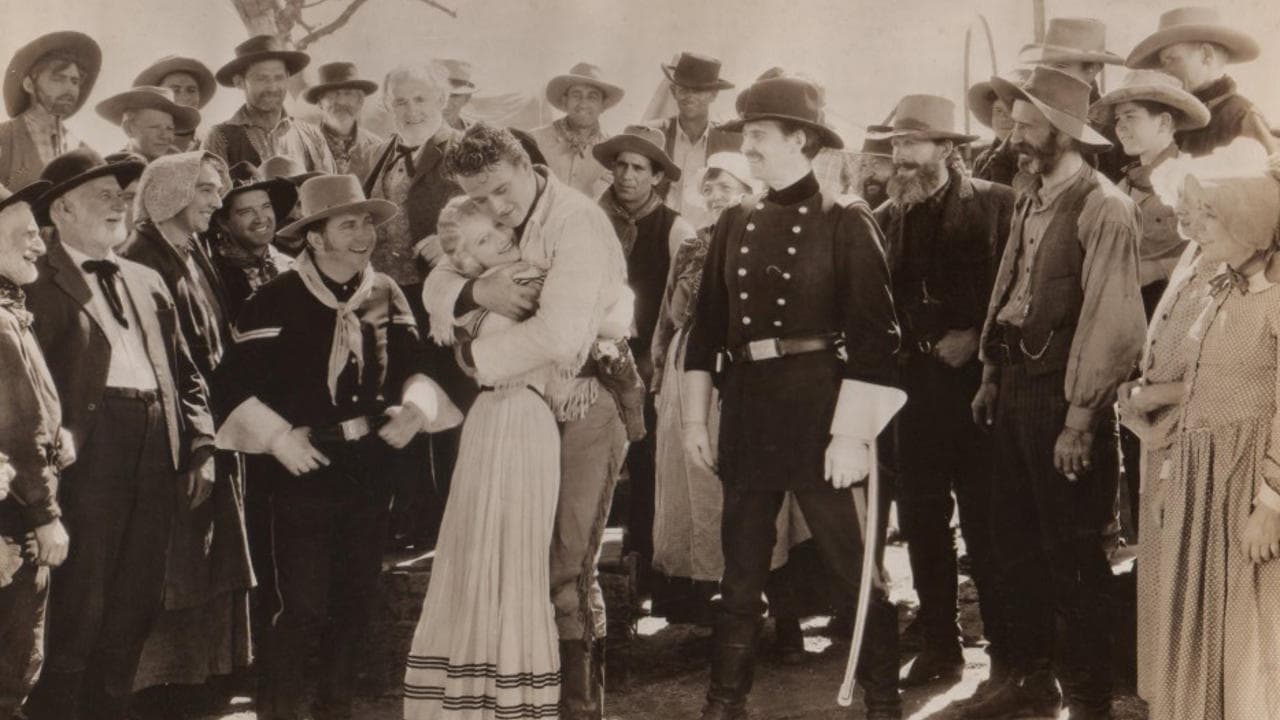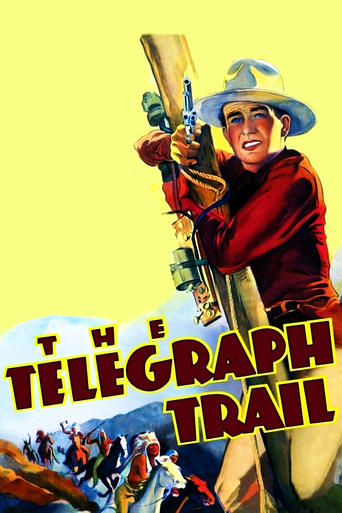

This early John Wayne B-movie is apparently not in the public domain--unlike many of his early films. This Leon Schlessinger film has been released by Warner Brothers/Turner Classic Movies instead of the usual cheap public domain videos you see in bargain bins. Unfortunately, however, despite this higher pedigree (and a slightly better quality print), this isn't all it's cracked up to be--there are no DVD extras nor are there any captions. It's a rather unimpressive release for Warner/TCM.Instead of the usual sidekicks (such as the ubiquitous Gabby Hayes), this one features Frank McHugh. While he's a very common actor in Schlessinger (whose studio was soon bought by Warner) and Warner Brothers films of the era, I can only recall a few times where he appeared in westerns. He was more of the comic relief in contemporary period pieces--though he does a very nice job here and looked pretty comfortable on a horse.The film begins with a group of telegraph installers being attacked by American-Indians. These Indiand, however, were orchestrated by a jerk named Lynch--who wanted to keep the telegraph and civilization away in order to force the settlers to deal with only him and his over-priced supplies. Although one of the telegraph men is shot, he's still able to relay a message to the fort many miles away--and Wayne and McHugh come to investigate. The message told what was happening but the man couldn't finish his transmission--and Wayne is trying to discover who the white man is who is stirring up all the Indian trouble. This is a weak point of the film, as it's 100% obvious who is behind it--there's no suspense whatsoever! Later, a lady overhears Lynch's plans to attack another group of telegraph installers. I have no idea why she didn't just tell Wayne. Instead, she devised a ridiculously complicated and sure to fail method to alert Wayne without revealing her identity. Why....?! And, as she was a witness to the conspiracy between Lynch and the Indian (Yakima Canutt), why didn't she just tell everyone so that Lynch would be arrested and...um...lynched! Then, they all could have gone out for pizza and had a party. Instead, the film went on for another 30 minutes---climaxing with a clichéd Indian attack--which is headed off at the last minutes by (surprise of surprises) the US Cavalry! The are absolutely no major surprises in this film. As usual, Wayne is very good and McHugh was a much better than normal sidekick...but even these couldn't overcome bad writing--even by cheap B-movie standards! It is entertaining...but a bit brainless.
... View MoreThis kid-friendly Oater was obviously intended for the Saturday morning double-features which droves of kids attended in the 30's and 40's. Mom & Dad dropped you off while they did the weekly shopping and you had a double-feature, a couple of cartoons, a 3-Stooges short and a Movietone news to entertain you, all for a dime. I know because I saw hundreds of them. Anyway, about this picture, it pays very little homage to the so-called plot which involves something to do with the new invention of the telegraph bringing communication across the continent. It has hundreds of extras (they must have been cheap to hire in those days) dressed as settlers, cavalry or Indians backing up the star (John Wayne) and the requisite pretty lady played by Marceline Day. In those days, the studio executives must have been convinced that the Cowboy and his faithful horse sidekick (ala Roy Rogers and Trigger) was a winning formula, so they paired John Wayne with a beautiful white stallion named Duke. The major attraction of this movie is the continual series of sight gags and gaffes which we never noticed as kids. In one scene, John Wayne is on top of a telegraph pole sending a message back to the Fort and a crowd of 10-12 Indians rides up and begins shooting at him. Wayne pulls his trusty six-shooter, fires once, and kills the Indian with the headdress. THEN WAYNE PUTS HIS GUN BACK IN HIS HOLSTER! What kind of direction was that? Can you believe John Wayne ever quit fighting a hoard of enemies in his life? Well, he does in this movie. I guess it was because he wanted to wait until the Indians fired off a volley at him; this would allow him to pretend to be hit so that he could fall off the pole (ouch!) and fake his death. Naturally, the gullible Indians were fooled, so they rode off at an accelerated gallop (all the galloping scenes are speeded up about 20% to make things more exciting), and before they have gone 50 yards, we see John Wayne getting to his feet. Then we find out that he wanted the feathered headdress so he could strip off his shirt (showing the manly Wayne chest), don the headdress and, pretending to be an Indian, join the Indians attacking the settlers, and then slip through the line of wagons (in a circle, naturally) and reenter the camp where he can join up with the beautiful girl. Of course, he can't begin fighting the circling Indians until he ducks into a tent and grabs a beautiful fringed-leather shirt and puts it on. One must be properly dressed when fighting Indians! All in all, this movie is fun to watch and if you are an old codger like me, it will bring back lots of wonderful memories of all those Saturday mornings long ago.
... View MoreAt this point in his career John Wayne was doing B films for Warner Brothers and it was decided to give him a smart horse like Roy Rogers's Trigger. And what do they name the horse? Duke. That's something Wayne must have had a hand in.Here John Wayne is an army scout and he gets Frank McHugh as an army corporal/telegrapher as sidekick. When a good friend of their's is killed while sending a message for help by wire during an Indian attack, these two are sent to take personal charge of the construction of the last leg of the telegraph.There's a nasty villain played by Frank Hagney who runs a shipping outfit and with his Indian friends wants to keep the telegraph out. How the telegraph would affect his business is never quite made clear, but this is a B western so plot holes back then were a pretty common occurrence.Wayne and McHugh are very effective together, too bad they never got to work together again. For those who've never seen the entire film, the last minute of The Telegraph Trail are seen in Footlight Parade in a scene where James Cagney is in a movie theater observing his competition as he's a director of stage musicals. Ironically enough Frank McHugh is also in the cast of Footlight Parade which makes one wonder how the Warner Brothers slipped up there.By the way, for the only time I can recall in any of his films, John Wayne sports a two gun holster. Butts reversed in the manner of Wild Bill Elliott. If anyone can recall another film he did like that, I'll correct this review. I would recommend The Telegraph Trail for Wayne fans to see how well he and Frank McHugh connect. Another twist in his career and Frank McHugh could have had a grand career as western sidekicks.
... View MoreThis early John Wayne western has the frequently used plot of some baddies convincing indians that the white men are up to no good, in this case by building a telegraph line to connect the east and west. But I still had some fun watching it, mostly because of the comedy by both Frank McHugh and Otis Harlan. In their funniest scene, they get drunk while the indians are attacking and they are bleary-eyed enough to think one bullet fells as many as 8 indians. The scene itself, in the middle of a battle in which many are killed, indicates director Tenny Wright did not direct with a heavy hand; I sensed a light-hearted touch throughout, which was a welcome change from most of these westerns. I also laughed whenever some clichéd event occurred, such as the love interest, Marceline Day, overhearing the the baddies talking about the upcoming ambush and getting the information to Wayne. And Wayne's horse, Duke, enters the fight by kicking indians when he was in a tent and observes their silhouettes against the tent wall. No wonder he was billed second in the opening credits, but I still wondered how the other actors felt about being outbilled by a horse.
... View More